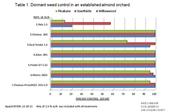- Author: Mick Canevari
- Author: Brent Holtz
- Posted by: Brad Hanson

Mick Canevari, Emeritus Farm Advisor and Brent Holtz, Farm Advisor, County Director
Weeds have a tremendous capacity to spread within an orchard. The first line of defense is identifying the weeds you need to control, and selecting the best herbicides or cultural practices to control those weeds. If you use the same herbicide(s) each year, a shift to tolerant weed species will ultimately take over and a loss of herbicide effectiveness will occur. Alternating products with different modes of action at least every couple years will improve results and insure herbicides long term viability. The UCIPM web site has charts that show which weeds are controlled...
- Author: Gale Perez
Below is a link to the Nov. 2012 UCCE San Joaquin County newsletter Field Notes. Page 8 has an article by Mick Canevari (Emeritus Farm Advisor) and Brent Holtz (Farm Advisor, County Director) on dormant weed control in tree nut crops.
http://cesanjoaquin.ucanr.edu/newsletters/Field_Notes_Newsletter44986.pdf
- Author: Richard Smith
- Author: Larry Bettiga
- Author: Brad Hanson
Marestail (Conyza canadensis; aka horseweed) and hairy fleabane (C. bonariensis; aka flax leaf fleabane) are serious weed problems in vineyards in Monterey County. Both plants are summer annuals that germinate in the fall at the onset of the rainy season (October – February), or germinate in the spring (March – May). Seeds of both species are not long lived (2-3 years) and are ready to germinate when conditions allow as soon as they mature on the plant; they germinate on the soil surface or from no greater than 0.2 inch deep. The seedlings of the two species look very similar to each other until they bolt at which time they can be easily distinguished (for detailed information on these species go to:...
- Author: Brad Hanson
Over the past few years, herbicides with the active ingredient glufosinate (Rely, Rely 200, Rely 280) have become very important in California tree nut orchards and grape vineyards.
Glufosinate is classified as a "Group 10, or Group B" herbicide an inhibits an enzyme important in the production of the amino acids glutamine in plants. Although it sounds similar to another amino acid inhibitor, glyhosate (the active in Roundup and others) glufosinate works quite differently than the Group 9 herbicide glyphosate.
- Author: Brad Hanson
It's that time of the year when I try to update the list of herbicides registered for use in California orchard and vineyard crops. The attached version has all the updates that I have been made aware of by my industry reps during the year. However, I have not done my end-of-year-herbicide-label-reading-marathon yet so it may change slightly over the next few weeks once I do that. Over the next few weeks, I'll try to discuss some of the more important changes in the T&V herbicide landscape.
Today, I'll focus on what could be important news for vineyard weed managers, registration of a new active ingredient for grape vineyards. Flazasulfuron (trade name: Mission...


